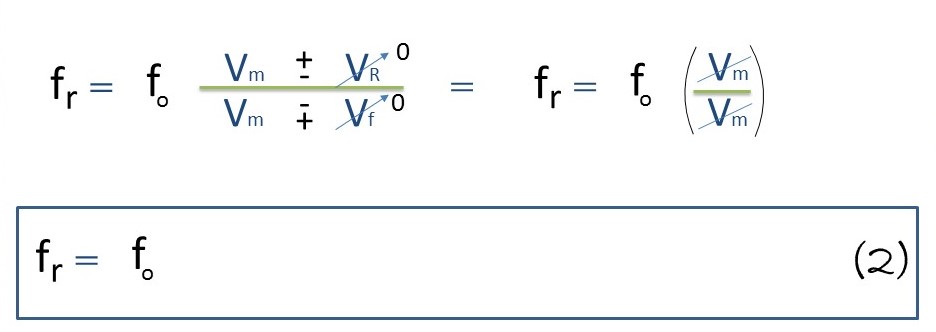Receiver and emitting focus of a motionless sound, under these conditions can the Doppler effect be generated? / (Eng-Esp)

First condition: Receiver immobile, and sound emitting focus in motion.Link
Second condition: Receiver in motion, and sound emitter immobile.Link
Third condition: Receiver and emitter of sound, both in motion.Link
Then we continue with the calculation of other variables, such as:
Travel speed of an acoustic signal receiver (VR).Link
The frequency of the emitting source of a given sound (fo).Link
The speed of the sound emission source (Vf) Link
The velocity of the propagating medium (Vm) of an acoustic signalLink
With the development of all these variables we fulfill the complete description of this formulation of the Doppler effect, but, in this opportunity, we will analyze what happens when both the receiver and the emitting focus of a sound are immobile.
As we have done so far, we will focus on another practical exercise as you can see below:
Exercise
In a small music recording studio, a professional percussionist is rehearsing some drum rhythms inherent to his work, this musical instrument is motionless, and inside the studio is a person sitting enjoying each of these fascinating drum rhythms, the medium of propagation of each musical note is the air, and the frequency of emission of musical sound is 440 Hz, in relation to all the characteristics described above answer the following questions:
a.-Under the conditions of immobility of the receiver and emitter of the sound, is it possible for the Doppler effect to develop?
b.- In relation to the previous question, what would be the frequency perceived by the receiver, and is it possible that any particle present in the propagation medium is displaced by the action of these sound waves?
Solution
First of all, we continue to point out the general equation of the Doppler effect with which we have worked in all previous articles, and with the respective description of each of its variables:

fr = It is the frequency of the sound perceived by the receiver.
fo = Represents the sound frequency of the emitting source.
Vm = Velocity of the sound propagation medium (air in this case)
VR = Receiver speed.
Vf = Speed of the sound emitting source.
Data:
fr = ?
fo = 440 Hz.
Vm = 340 m/s
Vf = 0 m/s, for being immobile.
VR = 0 m/s, for being immobile.
a.- When observing each of the data provided, both the speed of the receiver and the emitting focus of the sound is null, both are motionless, remember that for the development of the Doppler effect it is essential that there is mobility in some of the elements involved, that is, either the receiver or emitter of a particular sound, however, we could see this much better by answering the following question.
b.- To answer this question, we will focus on the general formulation of this phenomenon, i.e. formula 1, and simplify it in relation to the immobility of both the receiver and the source of the sound, reducing it to the following expression:

In this way we have that the frequency received by the receiver is the same frequency with which each musical note is emitted, in this case, 440 HZ, so the Doppler effect phenomenon will not develop under these immobility of both the receiver and the emitting focus of the sound, as it was verified by simplifying the general equation of the Doppler effect.
The particles present in the material or elastic medium used for sound propagation will not move with this type of sound waves; they will oscillate perpendicularly to these waves in relation to a stable equilibrium point.
Analysis of results
It was necessary to clarify this condition, where both the receiver and the source of emission of a given sound are immobile, leading us to demonstrate that under these conditions the analyzed phenomenon of the Doppler effect is not generated, so the receiver will perceive the sound at the same frequency at which it is emitted, in this case at 440 Hz.
Through acoustic science it has been determined how each musical instrument emits a set of notes, these instruments have particular timbres, however, these instruments can emit sounds at the same frequency, this leads us to express that sound is an essential part of our existence, that is why, the great importance of the analysis of any phenomenon related to it, as we have done with the wonderful phenomenon of the Doppler effect.
Until another opportunity my dear friends.
Note: The images were made by the author using Power Point and Paint, and the gif image was made with PhotoScape.
Recommended Bibliographic References
[1] MOVIMIENTO ONDULATORIO. Link.
[2] Doppler Effect. Link.
[3] SPEED OF SOUND. Link.
Spanish version
Primera condición: Receptor inmóvil, y foco emisor de sonido en movimiento.Link
Segunda condición: Receptor en movimiento, y emisor de sonido inmóvil.Link
Tercera condición: Receptor y emisor de sonido, ambos en movimiento.Link
Luego seguimos con el cálculo de otras variables tales como:
Velocidad de desplazamiento de un receptor de señal acústica (VR).Link
La frecuencia del foco emisor de determinado sonido (fo).Link
La velocidad de la fuente de emisión del sonido (Vf) Link
La velocidad del medio de propagación (Vm) de una señal acústicaLink
Con el desarrollo de todas estas variables cumplimos con la descripción completa de dicha formulación del efecto Doppler, pero, en esta oportunidad, analizaremos que ocurre cuando tanto el receptor como el foco emisor de un sonido se encuentran ambos inmóviles.
Como lo hemos hecho hasta ahora, nos centraremos en otro ejercicio práctico como el que pueden ver a continuación:
Ejercicio
En un pequeño estudio de grabación musical, un percusionista profesional se encuentra ensayando algunos ritmos de tambores inherentes a su trabajo, dicho instrumento musical está inmóvil, y dentro del estudio se encuentra una persona sentada disfrutando de cada uno de estos fascinantes ritmos de tambores, el medio de propagación de cada nota musical es el aire, y la frecuencia de emisión del sonido musical es de 440 Hz, en relación a todas las características antes descritas responder a las siguientes interrogantes:
a.- ¿Bajo las condiciones de inmovilidad del receptor y emisor del sonido, es posible que se desarrolle el efecto Doppler?
b.-En relación a la anterior interrogante ¿Cuál sería la frecuencia percibida por el receptor, y es posible que alguna partícula presente en el medio de propagación se desplace por la acción de estas ondas sonoras?
Solución
En primer lugar, seguimos señalando la ecuación general del efecto Doppler con la cual se ha trabajado en todos los anteriores artículos, y con la respectiva descripción de cada una de sus variables:

fr = Es la frecuencia del sonido percibida por el receptor.
fo = Representa la frecuencia del sonido del foco emisor.
Vm = Velocidad del medio de propagación del sonido (El aire en este caso)
VR = Velocidad del receptor.
Vf = Velocidad del foco emisor del sonido.
Datos:
fr = ?
fo = 440 Hz.
Vm = 340 m/s
Vf = 0 m/s, por estar inmóvil.
VR = 0 m/s, por estar inmóvil.
a.- Al observar cada uno de los datos suministrados tanto la velocidad del receptor como del foco emisor del sonido es nula, ambos están inmóviles, recordemos que para el desarrollo del efecto Doppler es fundamental que exista movilidad en algunos de los elementos involucrados, es decir, bien sea el receptor o emisor de un determinado sonido, sin embargo, esto lo podríamos ver mucho mejor al responder la siguiente interrogante.
b.- Para responder dicha interrogante nos centraremos en la formulación general de este fenómeno, es decir, la fórmula 1, y la simplificaremos en relación a la inmovilidad tanto del receptor como del foco emisor del sonido, quedando reducida a la siguiente expresión:

De esta manera tenemos que la frecuencia recibida por el receptor es la misma frecuencia con la que se emiten cada nota musical, en este caso, 440 HZ, por lo que el fenómeno del efecto Doppler no se desarrollara bajo estas de inmovilidad tanto del receptor como del foco emisor del sonido, tal y como se comprobó al simplificar la ecuación general del efecto Doppler.
Las partículas presentes en el medio material o elástico utilizado para la propagación del sonido, no se desplazarán con este tipo de ondas sonoras, lo que harían es oscilar perpendicularmente a dichas ondas en relación a un punto de equilibrio estable.
Análisis de los resultados
Era necesario aclarar esta condición, en donde, tanto el receptor como el foco de emisión de un determinado sonido ambos se encuentran inmóviles, llevándonos a demostrar que bajo estas condiciones no se genera el analizado fenómeno del efecto Doppler, por lo que el receptor percibirá el sonido a la misma frecuencia con la que se emite, en este caso a 440 Hz.
A través de la ciencia acústica se ha determinado como cada instrumento musical emite un conjunto de notas, dichos instrumentos poseen particulares timbres, sin embargo, estos instrumentos pueden emitir sonidos a la misma frecuencia, esto nos lleva a expresar que el sonido forma parte esencial de nuestra existencia, es por eso, de la gran importancia del análisis de cualquier fenómeno relacionado al mismo, como lo hemos hecho con el maravilloso fenómeno del efecto Doppler.
Hasta otra oportunidad mis queridos amigos.
Nota: Las imágenes fueron realizadas por el autor utilizando Power Point y Paint, y la imagen gif realizado con PhotoScape.
Referencias Bibliográficas recomendadas
[1] MOVIMIENTO ONDULATORIO. Link.
[2] Doppler Effect. Link.
[3] SPEED OF SOUND. Link.
Su post ha sido valorado por @ramonycajal
Gracias a la gran familia de @Cervantes por el valioso apoyo. Saludos.
Thanks for your contribution to the STEMsocial community. Feel free to join us on discord to get to know the rest of us!
Please consider delegating to the @stemsocial account (85% of the curation rewards are returned).
You may also include @stemsocial as a beneficiary of the rewards of this post to get a stronger support.
Thank you dear @stemsocial community for your support. Regards.
thanks a lot sharing this class

!1UP
Thank you for your visit and support. Best regards.
You have received a 1UP from @gwajnberg!
@ccc-curator, @stem-curator, @neoxag-curator
And they will bring !PIZZA 🍕.
Learn more about our delegation service to earn daily rewards. Join the Cartel on Discord.
Thank you for your support.
I gifted $PIZZA slices here:
@curation-cartel(19/20) tipped @rbalzan79 (x1)
Send $PIZZA tips in Discord via tip.cc!
Thank you for your support.